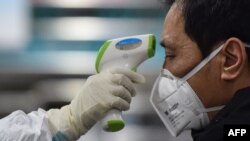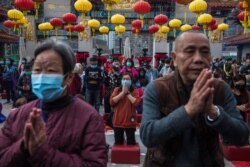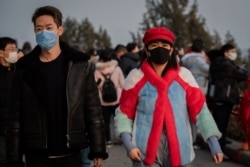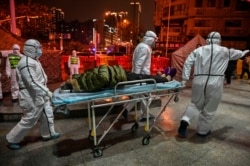The new virus accelerated its spread in China with 56 deaths so far in what the country’s leader called a grave situation, and the government stepped up efforts to restrict travel and public gatherings while rushing medical staff and supplies to the closed-off city at the center of the outbreak.
The figures reported Sunday morning covered the previous 24 hours and marked an increase of 15 deaths and 688 cases for a total of 1,975 infections.
The government also reported five cases in Hong Kong, two in Macao and three in Taiwan. Small numbers of cases have been found in Thailand, Japan, South Korea, the U.S., Vietnam, Singapore, Malaysia, Nepal, France and Australia.
Canada said it discovered its first case; the man is his 50s and recently flew from Wuhan to Guangzhou, China, and then on to Toronto.
President Xi Jinping on Saturday called the spreading illness a grave situation in remarks reported by state broadcaster CCTV. He spoke at a meeting of Communist Party leaders convened on Lunar New Year — the country’s biggest holiday whose celebrations have been muted — and underlined the government’s urgent, expanding efforts to control the outbreak.
Travel agencies have been told to halt all group tours, the state-owned English-language China Daily newspaper reported, citing the China Association of Travel Services.
Millions of people traveling during the holiday have fueled the spread of the outbreak nationwide and overseas after it began in the city of Wuhan in central China. The vast majority of the infections and all the deaths have been in mainland China, but fresh cases are popping up.
Singapore reported its fourth case on Sunday, a 36-year-old man from Wuhan. The Health Ministry said he did not exhibit any symptoms on his flight. He developed a cough the next day, sought treatment on January 24 and was immediately isolated.
South Korea confirmed its third case, according to Yonhap news agency.
In the heart of the outbreak where 11 million residents are already on lockdown, Wuhan banned most vehicle use, including private cars, in downtown areas starting Sunday, state media reported. Only authorized vehicles will be permitted, the reports said.
The city will assign 6,000 taxis to neighborhoods, under the management of resident committees, to help people get around if they need to, China Daily said.
Hong Kong's response
In Hong Kong, leader Carrie Lam said her government would raise its response level to emergency, the highest one, and close primary and secondary schools for two more weeks on top of next week’s Lunar New Year holiday. They will reopen February 17.
Lam said direct flights and trains from Wuhan would be blocked.
In a sign of the growing strain on Wuhan’s health care system, the official Xinhua News Agency reported that the city planned to build a second makeshift hospital with about 1,000 beds. The city has said another hospital was expected to be completed February 3.
The new virus comes from a large family of what are known as coronaviruses, some causing nothing worse than a cold. It causes cold- and flu-like symptoms, including cough and fever, and in more severe cases, shortness of breath. It can worsen to pneumonia, which can be fatal.
China cut off trains, planes and other links to Wuhan on Wednesday, as well as public transportation within the city, and has steadily expanded a lockdown to 16 surrounding cities with a combined population of more than 50 million — greater than that of New York, London, Paris and Moscow combined.
China’s biggest holiday, Lunar New Year, unfolded Saturday in the shadow of the virus. Authorities canceled a host of events and closed major tourist destinations and movie theaters.
Temples, Disneyland close
Temples locked their doors, Beijing’s Forbidden City and Shanghai Disneyland closed, and people canceled restaurant reservations ahead of the holiday, normally a time of family reunions, sightseeing trips and other festivities in the country of 1.4 billion people.
“We originally planned to go back to my wife’s hometown and bought train tickets to depart this afternoon,” said Li Mengbin, who was on a stroll near the closed Forbidden City. “We ended up canceling. But I’m still happy to celebrate the new year in Beijing, which I hadn’t for several years.”
Temples and parks were decorated with red streamers, paper lanterns and booths, but some places started dismantling the decor.
People in China wore medical masks to public places like grocery stores, where workers dispensed hand sanitizer to customers. Some parts of the country had checkpoints for temperature readings and made masks mandatory.
French automaker PSA Group said it would evacuate its employees from Wuhan, quarantine them and then bring them to France. The Foreign Ministry said it was working on “eventual options” to evacuate French citizens from Wuhan “who want to leave.” It didn’t elaborate.
The National Health Commission said it was bringing in medical teams to help handle the outbreak, a day after videos circulating online showed throngs of frantic people in masks lined up for examinations and complaints that family members had been turned away at hospitals that were at capacity.
Military staff
The Chinese military dispatched 450 medical staff, some with experience in past outbreaks, including SARS and Ebola, who arrived in Wuhan late Friday to help treat many patients hospitalized with viral pneumonia, Xinhua reported.
Xinhua also said medical supplies were being rushed to the city, including 14,000 protective suits, 110,000 pairs of gloves, and masks and goggles.
The rapid increase in reported deaths and illnesses does not necessarily mean the crisis is getting worse but could reflect better monitoring and reporting of the virus.
It is not clear how lethal the new coronavirus is or even whether it is as dangerous as the ordinary flu, which kills tens of thousands of people every year in the U.S. alone.











